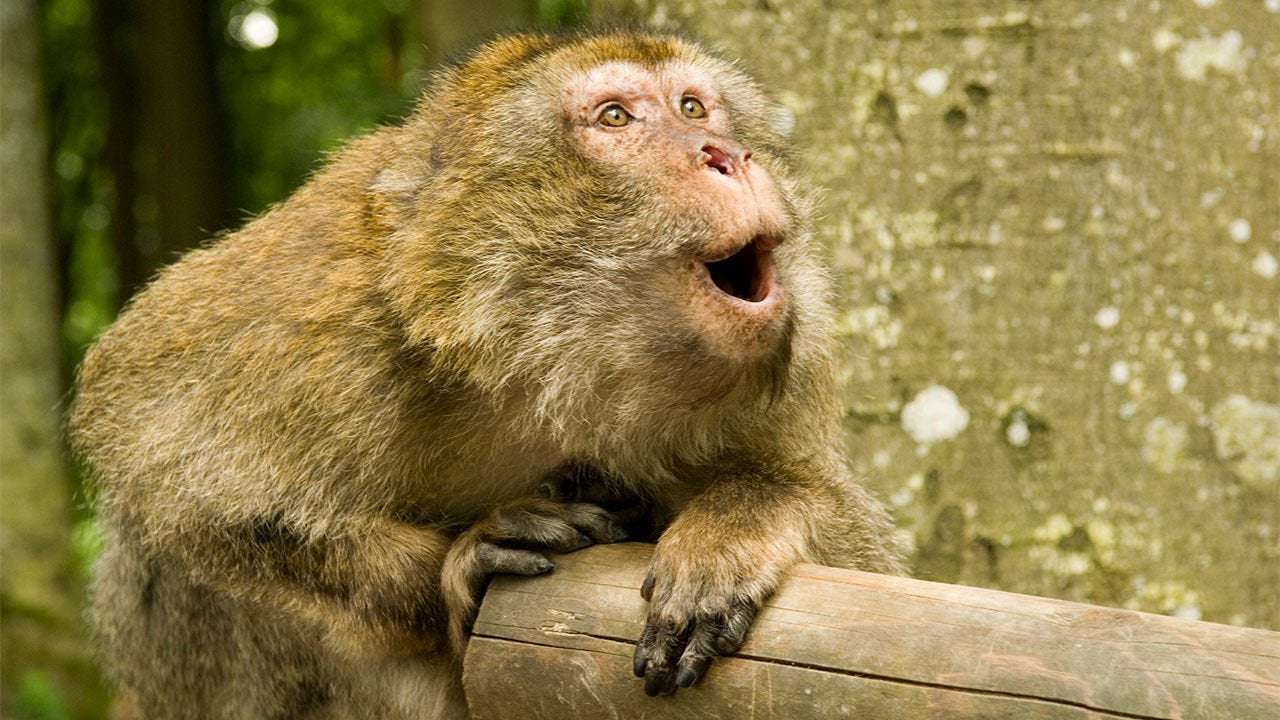The famed parrot Alex had a vocabulary of more than 100 words. Kosik the elephant learned to “speak” a bit of Korean by using the tip of his trunk the way people whistle with their fingers. So it’s puzzling that our closest primate cousins are limited to hoots, coos, and grunts. For decades, monkeys’ and apes’ vocal anatomy has been blamed for their inability to reproduce human speech sounds, but a new study suggests macaque monkeys—and by extension, other primates—could indeed talk if they only possessed the brain wiring to do so. The findings might provide new clues to anthropologists and language researchers looking to pin down when humans learned to speak.
“This certainly shows that the macaque vocal tract is capable of a lot more than has previously been assumed,” says John Esling, a linguist and phonetics expert at the University of Victoria in Canada, who was not involved with the work.
The study’s lead author, William Tecumseh Sherman Fitch III, an evolutionary biologist and cognitive scientist at the University of Vienna, says the question of why monkeys and apes can’t speak goes back to Darwin. (Yes, Fitch is the great-great-great-grandson of U.S. Civil War General William Tecumseh Sherman.) Darwin thought nonhuman primates couldn’t talk because they didn’t have the brains, he says. But over time, anthropologists instead embraced the idea that the primates’ vocal tracts were holding them back: They simply lacked the flexibility to produce the wide range of vowels present in human speech. That remains the “textbook answer” today, Fitch says.
He and study co-author Asif Ghazanfar, a neuroscientist at Princeton University, suspected Darwin had it right. So they trained Emiliano, a long-tailed macaque at Princeton’s primate lab, to sit in a chair while they shot x-ray video of him eating, yawning, and making a variety of vocalizations and lip smacks.
Analyzing x-ray stills from the video, the team assembled a collection of 99 different configurations of Emiliano’s vocal tract, which is the open space sound flows through as it emerges from the larynx, then flows over the tongue and out the lips. “Essentially, we built up a model of all the possible things the monkey’s vocal anatomy could do,” Fitch says.
Next, the researchers employed a series of linguistic tools that measure which configurations of the lips, tongue, and larynx can produce the frequencies that correspond to various vowel sounds. Some languages have fewer than five vowels, the most common number, but vowels are essential to human speech. Calculating the macaque’s so-called “vowel space,” Fitch and Ghazanfar discovered that—at least theoretically—he, too, could produce five distinctive vowels, roughly equivalent to the A, E, I, O, and U in English.
Finally, the researchers input Emiliano’s vocal tract configurations into a computer program that simulates vowel and consonant production given different anatomical settings. They picked a phrase that would show off a wide vowel range, “Will you marry me?” and ran it through a simulation of the monkey’s vocal tract. Compared with a human, the simulated monkey’s voice sounds flat and gravelly, but the words are clear and comprehensible. (You can listen below.)
The results suggest that, anatomically speaking, macaques are perfectly well equipped for humanlike speech, the researchers report today in Science Advances . And because their vocal anatomy is nearly identical to that of other monkeys and apes—and to most other mammals—these animals are “speech-ready,” too, Fitch says.
So why can’t Emiliano shoot the breeze with his handlers? Monkeys and apes lack the neural control over their vocal tract muscles to properly configure them for speech, Fitch concludes. “If a human brain were in control, they could talk,” he says, though it remains a bit of a mystery why other animals can produce at least rudimentary speech.
At some point in the 8 million or so years since we diverged from chimpanzees, our closest living evolutionary relatives, human brains gained substantial control over the vocal tract, Fitch say. Anthropologists who scour the fossil record for evidence of when our hominin ancestors learned to speak are “wasting their time,” he says, because all human ancestors had vocal anatomies capable of speech. Instead, the field should focus on genetic factors, like the FOXP2 gene, known to be necessary for proper speech and language development, to figure out when humans gained the gift of gab.
Dan Dediu, a psycholinguist at the Max Planck Institute for Psycholinguistics in Nijmegen, the Netherlands, says the study’s results open new doors for investigating modern languages, as well. He thinks slight population-level differences in vocal anatomy could explain why various languages have different phonetic and phonological properties. “Even a monkey's vocal tract can support spoken language, but its fine [anatomical] details might determine what sort of spoken language actually emerges,” he says. “I might even think about adding to my simulations a monkey vocal tract and see what one gets.”
For more related coverage on our furry friends, visit our animal world topic page.

boones_farmer on May 23rd, 2021 at 13:24 UTC »
The shape of our esophagus and position of our tongues is equally important for our ability to speak. If you put a human brain in a primate body we could maybe approximate something like speech, but nothing like what humans can do.
puerile86 on May 23rd, 2021 at 11:54 UTC »
..and sing. Can you imagine singing monkeys?
ivoz06 on May 23rd, 2021 at 11:08 UTC »
I work with some people that have the same issue...lol